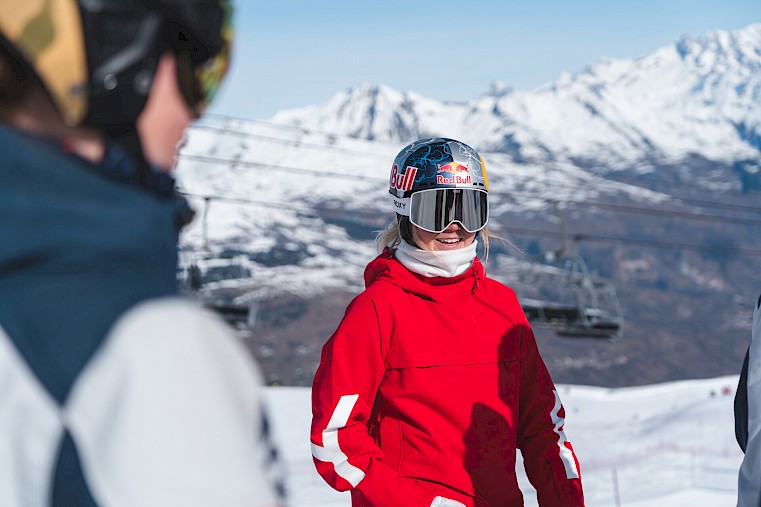Precious homemade skills and savoir-faire
Denis Verchère, flying: a visceral need
A unique character, passionate to the core as well as hyperactive, Denis has been flying for over 35 years although he is only 47. He gained media attention for his performances at the start of the 2000s when he was the youngest professional paraglider pilot. French media called him ‘strange bird’, ‘a clumsy albatross as soon as his feet are on the ground’.
Although his first love was paragliding, he is an all-round pilot of a rare versatility who has mastered parachuting, base jumping, hang gliding, mini-gliding, hot-air ballooning, helicopter flying and gliding, and he recently qualified as an airplane pilot.
If you are looking for Denis, he will either be in a cockpit or in the seat of his paraglider at the top of the Grande Rochette where he proposes tandem paraglider flights with or without acrobatics* (he prefers with!).
His accomplishments
- The first paraglider pilot to cross the Channel and the Strait of Gibraltar.
- With numerous videos to his credit, he won an Icare d'Or award for surfing on top of a hang glider
- Creating ‘Parapente Poursuite’ (Paraglider Pursuit), the world’s first board game about paragliding Parapente Poursuite - Pour les Parapentistes
‘I always wanted to fly. When I was little, I used to make parachutes for my Playmobiles! Then, when I was 10, I would inflate my first paragliders before doing my first solo flight when I was 12. I was totally obsessed!’
Denis Verchère, 360° pilot
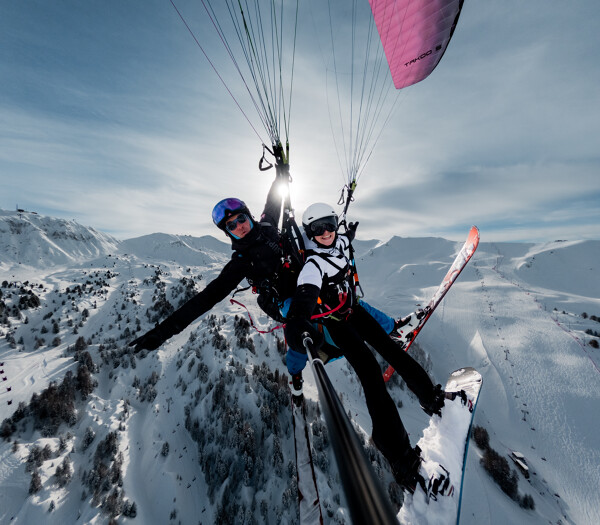
Damien Souvy, mountain guide and beekeeper
A dizzying move
In early July, two or three swarms from the nearby hives move into the wooden parts of the tower, 20 m above the ground. The insects are probably attracted by the pheromones on the wooden panels, as well as the tower’s favourable orientation. In 2017, it was Antoine Mercier, a local paraglider pilot and a beekeeper at the time, who made Damien aware of the need to put the swarms back in the hives: ‘Antoine was a beginner at climbing and I was a beginner beekeeper! I didn’t even eat honey. So it was quite an adventure to climb up there and remove the wooden panels that took up the whole width of the tower to get to the insects. I had to get the tower ready to host the French national climbing team. Antoine wanted to collect the bees for his hives, particularly as it’s expensive to buy them’.
Intrigued by the experience and curious by nature, Damien became interested in the insects, but it was a paragliding accident in 2019 that gave him the time to look at the world of beekeeping in more detail.
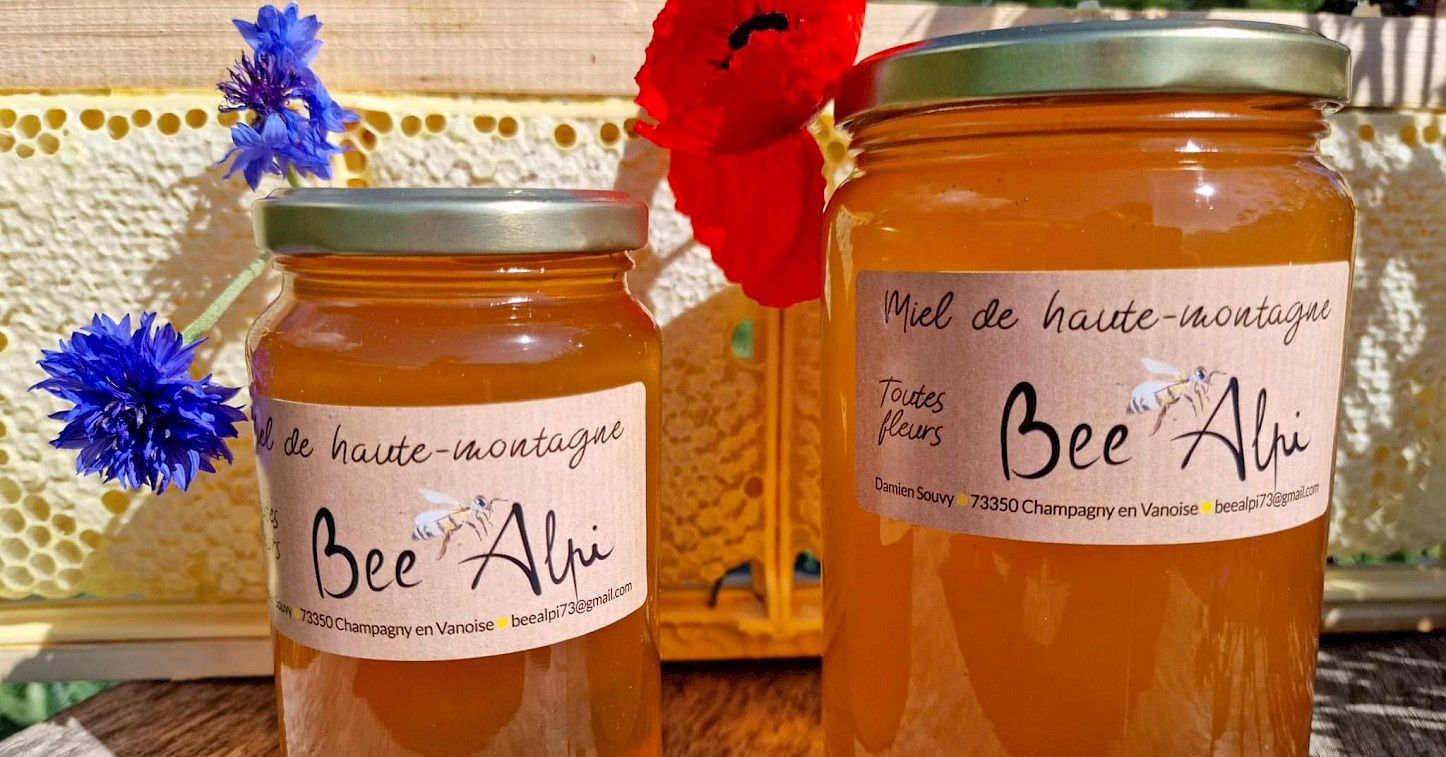
A beekeeper is born
This was how Damien started making his first jars of Bee Alpi honey: ‘While I was convalescing, I had time to teach myself and read up on the subject, learning as much as I could. I managed to start making honey quite quickly. These days, at the busiest moment of production, Damien manages more than 30 hives (80,000 bees / hive), producing 1.6 tonnes of honey, in other words over 40 kg per hive: ‘On a national scale, that is a good amount'. He attributes his consistent success to an ability to adapt constantly and to take into account a range of factors that favour (or not) the production of honey: ‘Being a beekeeper means considering a lot of details which are different every year. It’s a question of trial and error; you just have to get the hang of it, a bit like having green fingers with plants!’. Damien also looks after 15 hives with queen bees that are dedicated to reproduction.
Adapting to a rapidly changing climate
Nowadays, the intervention that consists of moving the swarms from the tower to the hives is almost a routine manoeuvre for Damien: ‘The tower has evolved and the volumes that have to be dismantled are much smaller. With my experience and the knowledge I now have of the bees, it is much easier’. The swarms recovered are used to (re)populate the nearby hives, even if they are not the most efficient bees. ‘Genetically, they are quite weak and they are not the best honey producers’. Like all beekeepers, Damien is seeing the impacts of climate change which are particularly evident in the mountains: ‘In spring, the temperature changes can be dangerous for the bees. A cold snap can weaken them and jeopardise future harvests. I have to be extremely vigilant and constantly adapt.’
https://www.facebook.com/BeeAlpi
There is no school where you can learn to be an ice specialist!
The bobsleigh track is part of La Plagne’s inheritance from the 1992 Albertville Olympic Games and now get prepared for winter JOP 2030! It is the only track in France and aspires to be an example of how to re-use a site post-Games. It employs a team of refrigeration and ice specialists whose jobs are unique in France and come with a major challenge: to model the most perfect and perfectly smooth ice profile down the track’s 1 500 m length, 19 bends and 125 m vertical drop. From October, the team of 12 to 26 ice specialists and 4 refrigeration technicians works painstakingly to achieve this result with precise gestures and a savoir-faire that is passed on and acquired only through experience.
> Behind the scenes of France’s biggest skating rink
Objective: to ice the 6800 m2 surface area (4.7 skating rinks) in just one month in 4 steps:
- start up the 3 compressors that have been in hibernation for 7 months
- cool the 1500 m long concrete structure with 90 km of pipes running through it using a refrigeration fluid composed of 50% water and 50% glycol
- spray water (from the source of an old mine and not suitable for consumption) onto the concrete at between -4°C and -5°C, then fill in / shape using 180 m³ of crushed ice
- refine the profile
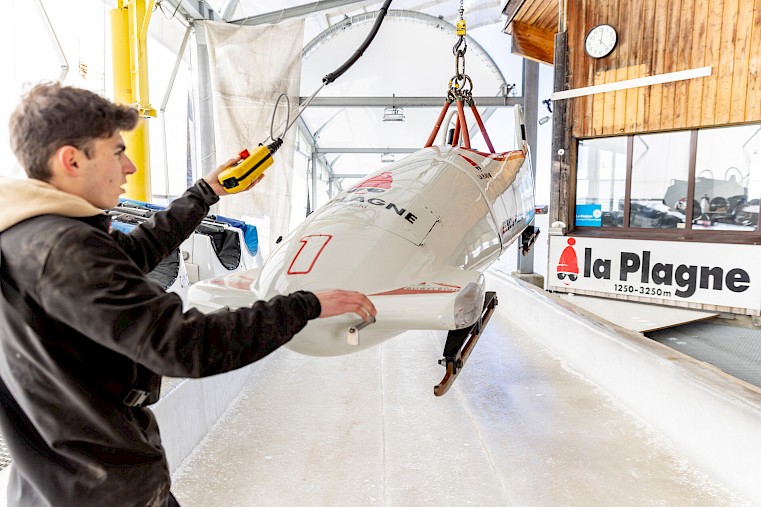
Skiing with "Gueule de Bois"
Wooden skis, but not like the ones you use to decorate your chalet! These are highly technical skis, nothing like the old-time “planks”, even if they are also made with noble wood and are “lovingly fashioned by hand”. The man behind the “Gueule de Bois” brand is 46 year old Manuel Chalopin, originally from Brittany but Savoyard by adoption. Manuel set up his workshop in the old sawmill in Longefoy (Montalbert) to make skis made from local species of wood (maple ash, spruce, poplar and chestnut). He designed two models: the “90” which is perfect for on the piste and the “100”, more suited to off-piste. “I worked as a ski man in a shop for a long time, From having tested the equipment, I know almost every model of every brand, with their good and bad points. With my models, I am looking for perfect skiing sensations". Also a musician who makes stringed instruments, Manuel discovered the pleasure of working with wood when he worked on the construction of log chalets in a previous professional life.
850 € for a pair of skis made entirely by hand.
https://www.gueuledebois-planchesetguitares.com/
Itw de Manuel Chalopin - Gueule de Bois
The only ski resort that is putting up its own ski lifts
The Société d’Aménagement de la Plagne is proud to say that it assembles all of its lifts in-house from A to Z! From the civil works to assembly, ten or so workers are on each site. This decision not to use subcontracted workers is unique these days in French ski resorts. Over the past ten years it has allowed the company to keep year-round jobs and to keep skills in-house for greater reactivity. Above all, it guarantees a total investment since, as the SAP’s general manager, Nicolas Provendie says, ”We never build things as well as when we are doing it for ourselves”. The SAP Montage team is currently working on the construction of the new Roche de Mio gondola.
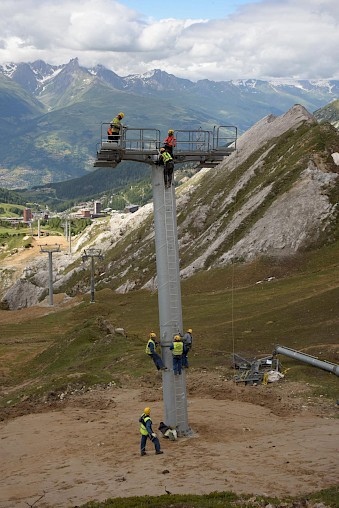
Champions and La Plagne, a long history
La Plagne currently has a pool of 13 top-level athletes under contract. They all wear La Plagne’s red hat logo and make the resort’s colours shine in over 7 winter sports disciplines, contributing to its international renown. They are the worthy heirs to a dynasty of champions, a legacy of talent that started with La Plagne’s first champion, Eric Laboureix, who led the way at the start of the 1980s in acrobatic skiing.
The budget allocated to backing our athletes totals 215,000 € which contributes to financing their season.
Tess, Louna and Romain, winning is in their blood
Sporting virtuosos, exceptional athletes, competitors who are marking the history of their sport: these are just some of the ways to present Tess Ledeux, Louna Ladevant and the very young Romain Allemand, who has just made a sensational debut on the world stage.
All 3 wear La Plagne’s colours and are raw talents who were propelled straight to the top of the sports hierarchy when they were still very young.
Tess and Louna’s domination has been virtually unchallenged for several years. As for Romain -qualified by the media as “phenomenal” and a “real prodigy” following his historic performance during his first appearance on the international circuit – he is already showing signs of a promising future, following in the footsteps of those who have gone before him.
Becoming and staying the best in their discipline is the story of their lives.

